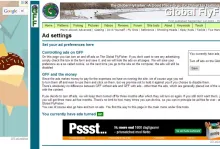I have build a small Drupal-module, which enables me to see how many recipients open my newsletters and click on links in it
Nerd alert
This is NOT about fly fishing or fly tying, but about site development and nerdy stuff.I send out newsletters from GFF about 4-5-6 times a year. It’s not exactly a newsletter, which bogs down the recipients’ inboxes, but it does after all reach more than 5,500 people, and because of that, I’d like to know how much interest it stirs and what traffic it generates.
For this I use the simplest imaginable technology, built into a small Drupal-module I coded myself.
For counting the number of people who open the newsletter, I use what I call a tracker image.
For counting the clicks I use a simple click forwarder.
Let me explain the two:
Tracker image
The principle is quite simple. Almost all modern newsletters contain images, and these are usually not sent with the mail, but fetched from a web server once the user opens the newsletter.
The trick is then to make one of these images in such a way that every opening of it is counted.
The simple way of doing this is by setting up a Drupal path, which leads to a function that adds to a counter, and then simply serves the image. The URL for this is then simply embedded in the HTML for the newsletter as an image, in other words as
<img src=”url-for-image?nid=nnn” />
In my case the URL also contains the nid of the newsletter, so that I can not only count the number of times the image is loaded, but also add to the counter for the proper newsletter. The counters are in the database, and are simply a table of nids and number of openings.
Every time a user opens a certain newsletter, the image gets loaded, and before sending it to the user’s email-client, the counter for the relevant nid (representing a newsletter) is incremented.
This is of course not a very granular way of counting. If a user opens the newsletter twice, it’s counted twice, but in my case that’s no big deal. The number still roughly indicates the interest in the newsletter.
A really good opening rate for the GFF newsletter is about 15% BTW, so essentially 85% of the recipients do not even open the newsletter! Mostly this number is lower, so the interest isn’t huge. But compared to many other newsletters, 15% is actually OK. 25% would be great, but hard to reach.
Counting clicks
Counting the clicks is equally simple. When the newsletter is generated, all links in it are exchanged for a link to a common URL, and the actual URL in the link is passed to this as a parameter. When the user clicks a link, it jumps via the counter URL, which again adds to a counter in the database for that particular URL and then forwards the user on to the “real” URL and shows the content that was linked in the newsletter. Again the nid of the newsletter is sent along so that I can count clicks on links to the same URL in different newsletters separately.
And again I can tell you that the click rates are even lower than the opening rates! A real stunner article may get 100-150 clicks, while the average is more like 30-40. On a good newsletter people who open the newsletter might click on about 0.5-2 links. Numbers below 1 means that some people open, but don’t click on anything. A killer newsletter might get 5 clicks for every time a newsletter is opened, but that’s really rare.
Longevity
In both the above cases I register the date and time of the latest openings and clicks, and I’m sometimes surprised how long after a newsletter has been sent, I still see incoming traffic.
A newsletter sent out March last year got its latest click in November this year, and the newsletter sent in May still gets almost daily openings and the odd click now and then – and we’re in December!
Still, in spite of their long lives, the newsletters aren’t exactly massive traffic generators. I could maybe do more to increase that by sending out more newsletters and perhaps be a little more aggressive in my writing and praise for the site and the content. On the other hand neither traffic nor newsletters are critical to the life of the site. The far majority of incoming traffic comes from search engines, from social media and from people who simply have the site in their bookmarks or type in the URL.
- Log in to post comments









